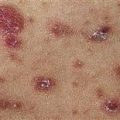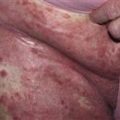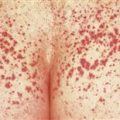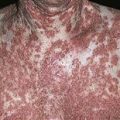96
Rocky Mountain
spotted fever
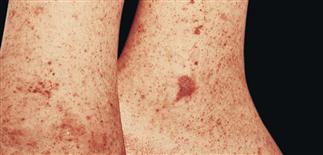
A generalized petechial eruption that involves the entire cutaneous surface, including the palms and the soles but characteristically appears first on the wrist and ankles.

Pinpoint palmar purpura of Rocky Mountain spotted fever.
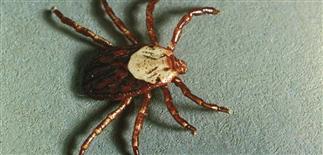
Rocky Mountain spotted fever is caused by an obligate intracellular coccobacillus R. rickettsi. It is transmitted by the bite of an infected Dermacentor or Ixodes tick.
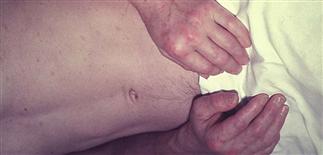
Rocky Mountain spotted fever presentation with pink to red inflamed macules on the wrists, dorsal hands and fingers, with early mild petechiae.
DESCRIPTION
Rocky Mountain spotted fever is a potentially lethal disease caused by Rickettsia rickettsii, a short, Gram-negative bacillary organism. Infection characterized by acute onset of fever, severe headache, myalgia, vomiting, and petechial rash. Transmitted by ticks, usually Dermacentor and Ixodes species. Organisms disseminate via the bloodstream and multiply in vascular endothelial cells. Condition occurs most commonly in the eastern USA and Brazil in summer and early autumn.
HISTORY
• Tick bites are typically painless, so patient may not recall a recent tick bite. • Travel to an endemic area and recent outdoor activity are helpful clues. Incubation period on average 6–8 days after bite. An abrupt onset of fever (95%), severe headache (90%), myalgia (85%), and vomiting (60%) occur.
PHYSICAL FINDINGS
• Skin findings evolve and appear a few days after fever. Signs of previous tick bite may not be found. Rash is discrete and macular, blanches with pressure, and becomes petechial in 2–4 days. It appears first on the wrists and ankles, which is very characteristic. Hours later, it involves the palms and soles (75%), then becomes generalized. Rash does not occur at all in about 15% of cases. • Multiple organs are involved in severe disease. Hepatosplenomegaly is present in 25–50%. Neurologic symptoms include seizures, meningitis, cranial nerve palsies. Respiratory distress, gastrointestinal bleeding, myocarditis, and retinal thrombosis rare but reported. • Fever subsides in 2–3 weeks, and rash fades with residual hyperpigmentation. Mortality rate in treated patients is 4%, and 20% in untreated patients. Many of those who die have a fulminant course and are dead in 1 week. • Indirect fluorescent antibody tests on acute and convalescent sera fairly accurate, can confirm diagnosis. • Systemic vasculitis and meningococcemia are the two other major diagnostic considerations in patients with Rocky Mountain spotted fever. • Serologic evidence appears in second week of infection. A titer greater than 1 : 128 is positive. The leukocyte count can be high, low, or normal; thrombocytopenia, elevated serum hepatic aminotransferase level, and hyponatremia are common.
TREATMENT
• Start empiric treatment if Rocky Mountain spotted fever suspected. Doxycycline 100 mg b.i.d. for at least 7 days and at least 48 h after resolution of fever is current treatment of choice. • Chloramphenicol 50 mg/kg q.d. is an alternative.


